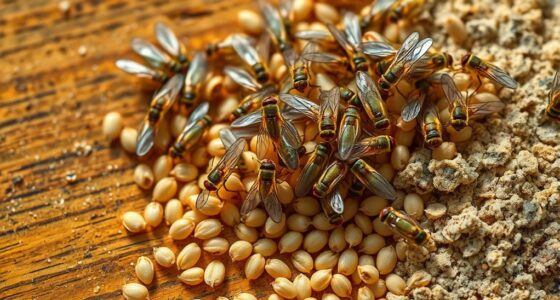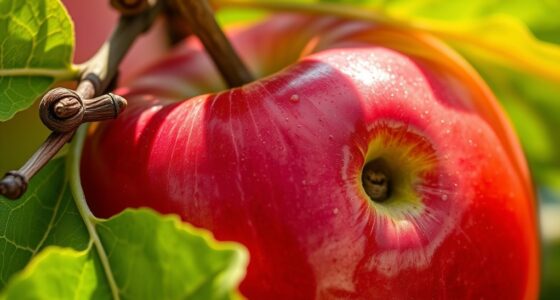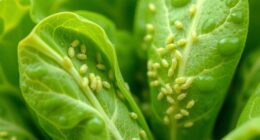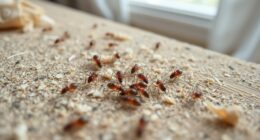To make accurate pruning cuts on pear trees affected by fire blight, you should first identify infected tissue by looking for dark, wilted, or scorched areas. Use sharp, sterilized tools to make clean cuts at a 45-degree angle just below the infected zone, removing all infected wood. Proper disposal of infected material and careful tool disinfection are essential to prevent further spread. Continuing with these practices guarantees your tree stays healthy and resilient. You’ll find more tips to help you succeed.
Key Takeaways
- Make cuts just below infected tissue to remove the bacterial source effectively.
- Use sharp, sterilized tools to ensure clean cuts and prevent pathogen spread.
- Make cuts at a 45-degree angle to promote proper drainage and healing.
- Prune during dormancy, preferably late winter or early spring before new growth begins.
- Disinfect tools after each cut and after handling infected material to prevent cross-contamination.
Recognizing Symptoms of Fire Blight in Pears

Fire blight quickly shows its presence through distinctive symptoms on pear trees. To identify disease symptoms early, pay close attention to your trees’ appearance. You’ll notice the leaves and blossoms turning brown or black, often appearing water-soaked or scorched. The affected shoots may bend into a shepherd’s crook shape as the bacteria spread, causing the tissue to ooze a sticky, amber-colored exudate. During symptom identification, look for sudden wilting and dieback of new growth, especially in spring. Infected fruit may also rot and develop dark, sunken spots. Recognizing these signs promptly helps you distinguish fire blight from other issues. Accurate disease symptoms detection is essential for effective management and minimizing damage to your pear trees. Color accuracy impacts overall image quality and can help in diagnosing plant health issues more precisely.
Timing of Pruning for Optimal Disease Control

Pruning at the right time is essential for controlling fire blight in pear trees, as it helps remove infected branches before the bacteria can spread further. Seasonal pruning is most effective during dormant periods, typically late winter or early spring before new growth begins. Timing ensures you target active infections early, reducing disease spread. Always use sharp pruning tools to make clean cuts, minimizing injury to the tree and preventing bacterial entry. Avoid pruning during wet or humid conditions, as this can promote bacterial transfer. Proper timing and technique help contain fire blight and promote healthy growth. Consider this schedule:
| Season | Best Pruning Time | Disease Control Focus |
|---|---|---|
| Late Winter | Before bud break | Remove dormant infections |
| Early Spring | Just before new growth starts | Minimize bacterial spread |
| Summer | Not recommended | Less effective for fire blight |
Additionally, implementing proper sanitation practices, such as disinfecting pruning tools between cuts, can significantly reduce bacterial transmission and improve disease management.
Tools Needed for Precise Pruning Cuts

Using the right tools guarantees you make clean, accurate cuts that help prevent the spread of fire blight. Essential tools include sharp hand pruners for small, precise cuts and pruning saws for larger branches. Make sure your pruners are well-maintained and clean to avoid transmitting disease. A pruning saw lets you reach and trim bigger limbs safely and efficiently. Imagine the following tools working seamlessly in your hand:
- Sharp hand pruners with bypass blades
- Compact pruning saw with a sturdy handle
- Long-handled loppers for reaching higher branches
- Disinfectant spray to keep tools sterile
- Protective gloves for safety and grip
Having these tools ready ensures your pruning is precise, minimizing damage and disease spread. Proper tools are essential for effective, safe fire blight management. Maintaining sterile tools is crucial to prevent the transmission of fire blight and other diseases.
Identifying the Correct Cutting Locations

Start by locating the areas showing fire blight symptoms, such as darkened, wilted, or scorched-looking tissues. Once identified, make your cuts just below these affected zones to remove the infection effectively. Properly choosing your cutting spots helps protect the healthy parts of your tree and promotes better recovery. Additionally, using appropriate pruning techniques ensures that the cuts are clean and reduces the risk of further disease spread.
Locate Symptom Areas
How can you accurately identify the areas affected by fire blight? Look for signs like:
- Dark, water-soaked lesions at branch tips
- Twisted, wilted, or scorched-looking leaves
- Dead or brownish streaks inside the bark
- Flower clusters that are shriveled or blackened
- Unusual growth patterns, such as spurts of new, weak shoots
Spotting these symptoms helps you target the right cuts for removal, reducing disease spread. During your inspection, consider flower thinning to prevent overly dense clusters, which can harbor pests and promote blight. Focus on areas where symptoms are concentrated, ensuring you prune just beyond the infected zone. This precise approach minimizes damage, promotes healthy growth, and helps maintain pest prevention efforts. Accurate symptom location is essential for effective fire blight management. Additionally, understanding proper pruning techniques can improve your disease control strategies.
Make Proper Cuts
Once you’ve identified the infected areas, the next step is making proper cuts to remove the diseased tissue. You should cut just outside the visible infection, making clean, angled cuts to prevent further spread. This helps preserve healthy tissue and supports the tree’s natural defenses. Proper cuts also improve soil health by reducing the risk of disease re-entry into the soil, which can harbor pathogens. Additionally, timely pruning limits pest habitats, aiding in pest control. Use sharp tools to ensure smooth cuts that heal quickly, minimizing stress on the tree. Always sterilize your pruning equipment between cuts to prevent cross-contamination. Correctly identifying the right cutting locations ensures you effectively remove infected tissue without harming healthy growth, promoting a resilient, productive pear tree. Understanding the arcade machine can provide insights into the mechanics behind game performance, which may be useful for troubleshooting or restoration.
Proper Technique for Making Clean Cuts

To effectively prevent the spread of fire blight, it’s essential to make clean, precise cuts on your pear trees. Proper technique guarantees healthy healing and reduces disease risk. Focus on pruning safety and timing to get the best results. When making a cut, picture these key points:
- Use sharp, sterilized tools to create smooth, clean edges
- Cut just outside the branch collar for ideal healing
- Avoid tearing or crushing tissue to prevent infection
- Make cuts at a 45-degree angle for quick drainage
- Remove dead or infected wood promptly during the correct pruning season
- Ensure your tools are compatible with your equipment, such as using the appropriate headphone jack type for comfortable operation and safety during pruning sessions.
Disinfecting Tools to Prevent Disease Spread

To stop the spread of fire blight, you need to sanitize your tools properly. Use a suitable disinfectant solution and follow the recommended cleaning methods to guarantee all pathogens are eliminated. Remember to disinfect your tools between cuts and after finishing your work to keep your trees healthy. Incorporating proper tool maintenance practices can further reduce the risk of disease transmission.
Proper Tool Cleaning Methods
Properly disinfecting your tools is essential to prevent the spread of fire blight among pear trees. Clean tools reduce disease transmission during pruning and support effective pest management. After each cut, you should:
- Wipe blades with a disinfectant-soaked cloth
- Dip tools into a disinfectant solution
- Rinse with clean water to remove residue
- Dry thoroughly to prevent rust
- Store in a clean, dry area between uses
These practices help maintain healthy trees and uphold good cultural practices. Consistent tool cleaning minimizes the risk of spreading fire blight and other pathogens. Using the right disinfectant ensures effective sterilization of tools. Remember, clean tools also promote overall pest management, reducing the chance of infestations that weaken trees. Incorporate proper tool cleaning into your routine for healthier, more resilient pear trees.
Use of Disinfectant Solutions
Using disinfectant solutions effectively is essential for preventing the spread of fire blight during pruning. You should always disinfect your tools between cuts to avoid transferring bacteria. Chemical treatment with a suitable disinfectant, such as a bleach solution or commercial disinfectant, kills fire blight bacteria on blades. Ensure tools are thoroughly rinsed and dried before next use. In addition to chemical treatment, biological control methods, like applying beneficial microorganisms, can reduce pathogen levels on tools and plant surfaces. These biological options provide an environmentally friendly alternative to harsh chemicals and can support overall plant health. Proper sterilization minimizes disease spread, protecting your pear trees from fire blight. Regularly disinfecting your pruning tools is a simple yet powerful step to maintain tree health and prevent infection. Necessary cookies help ensure that your disinfection process is properly tracked and optimized for best results.
Timing for Disinfection
Timing is critical when disinfecting tools to prevent the spread of fire blight. You should disinfect immediately after each cut to interrupt the pathogen’s survival. Maintain a consistent disinfection schedule, especially during peak infection periods, to minimize risk. Think of your tools as potential disease carriers—if you delay, you allow pathogens to survive and spread. Visualize:
- Wiping blades clean before moving to another branch
- Rinsing tools in disinfectant after each pruning session
- Ensuring disinfectant stays fresh and effective
- Avoiding cross-contamination between healthy and infected tissue
- Disinfecting at the end of each workday to eliminate lingering pathogens
Handling and Disposal of Infected Material

When dealing with infected pear tree material, it’s essential to handle it promptly and carefully to prevent the spread of fire blight. Proper disposal methods are crucial to eliminate infected material effectively. Collect fallen branches, twigs, and pruned sections using disinfected tools, and place them in sealed plastic bags. Do not compost infected material, as this can spread the bacteria. Instead, burn it if local regulations permit, or double-bag and discard it in the trash. Always disinfect pruning tools after handling infected material to avoid cross-contamination. Prompt removal and proper disposal stop the bacteria from infecting healthy parts of your trees or nearby plants. Acting quickly and following these disposal methods minimize the risk of fire blight spreading further in your orchard.
Pruning Strategies for Different Tree Ages and Structures

Pruning strategies must be tailored to the age and structure of your pear trees to promote healthy growth and fruit production. Young trees benefit from selective thinning to shape the canopy, ensuring sunlight reaches all parts. Mature trees require careful removal of dead or crossing branches to maintain airflow and reduce disease risk. For older or overgrown trees, radical pruning helps rejuvenate growth, but always consider the specific tree species. Proper pruning also aids pest control by removing hiding spots for pests and pathogens. Visualize your tree as a balanced sculpture:
- Thin out crowded branches
- Remove diseased or damaged wood
- Prune for open-center or central leader structure
- Keep a manageable height
- Maintain an even canopy for better light and air circulation
These strategies help keep your pear trees healthy and productive.
Monitoring and Maintaining Tree Health Post-Pruning

After pruning, you need to regularly inspect your pear trees for signs of fire blight or other diseases. Keep your tools and pruning sites clean to prevent spreading infections. Consistent monitoring and good sanitation help guarantee your trees stay healthy and resilient.
Regular Disease Inspection
Regular disease inspection is essential for keeping your pear trees healthy and preventing fire blight from taking hold. By regularly checking for early signs, you enhance damage prevention and improve disease monitoring. Look for:
- Dark, water-soaked spots on branches or fruit
- Oozing sap or sticky residues
- Wilting or blackening of blossoms and shoots
- Dead or dying leaves clinging to branches
- Unusual odors around affected areas
Visual cues like these help you catch problems early, reducing the risk of widespread infection. Use a sharp pruner to remove any suspicious growths promptly. Consistent inspections allow you to act quickly, minimizing damage and keeping your trees healthy. Staying vigilant is your best defense against fire blight, ensuring your pear trees thrive season after season.
Proper Sanitation Practices
Maintaining proper sanitation practices after inspecting your trees helps prevent the spread of fire blight and supports their ongoing health. Start by removing and properly disposing of pruned branches, ideally into a compost bin or trash, to eliminate infected material. Clean your pruning tools with disinfectant to prevent transferring bacteria to healthy tissue. Check the garden soil around your pear trees for signs of pests or disease, as pest control can reduce stress on the trees and lower infection risk. Keep the area clear of fallen leaves and infected debris, which can harbor bacteria. Regularly monitor your trees for new symptoms, and promptly address issues to maintain overall plant health. Consistent sanitation and pest control create a less hospitable environment for fire blight to thrive.
Integrating Pruning With Other Fire Blight Management Practices

To effectively manage fire blight on pear trees, you should combine pruning with other control strategies. This integrated approach enhances your efforts and minimizes disease spread. When pruning, focus on maintaining good pruning aesthetics to avoid unnecessary wounds, and choose tools with ergonomic designs for precision and comfort. Additionally, consider applying appropriate bactericides during bloom and monitoring weather conditions that favor infection. Implementing proper sanitation, such as removing fallen infected material, supports your pruning efforts. You can visualize your orchard as a well-coordinated team, where each action reinforces the other:
Combine pruning, sanitation, and timely treatments to effectively control fire blight on pear trees.
- Using sharp, comfortable tools for clean cuts
- Timing pruning during dry weather
- Applying antibiotics or copper sprays as needed
- Removing and destroying infected plant material
- Regularly inspecting trees for early signs of disease
Frequently Asked Questions
How Can I Differentiate Fire Blight From Other Pear Tree Diseases?
To differentiate fire blight from other pear tree diseases, look for specific disease symptoms like darkened, water-soaked shoots and dieback. Infection signs include ooze from infected branches and blackened, wilted leaves. Unlike other diseases, fire blight causes a distinctive “shepherd’s crook” bend in branches. Keep an eye out for these symptoms and signs to identify fire blight early and take appropriate control measures.
What Are the Best Pruning Practices During Wet or Humid Weather?
Ever wondered why pruning during humid weather feels challenging? When you face wet conditions pruning, always use sharp, clean tools to prevent disease spread. Prune in the morning when humidity drops or during dry spells, avoiding heavy cuts that can wound trees. During wet weather, focus on removing dead or diseased wood promptly. Proper pruning helps your pear trees stay healthy, resilient, and ready to produce fruit despite humid conditions.
Can Pruning Alone Eliminate Fire Blight From My Orchard?
Pruning alone won’t fully eliminate fire blight from your orchard, but it’s essential for control. You need to combine accurate pruning cuts with orchard sanitation—removing infected material—and apply bactericides promptly. Regularly disinfect tools to prevent spreading bacteria. This integrated approach reduces the disease’s spread and helps keep your pear trees healthier. Remember, early detection and consistent management are key to minimizing fire blight damage.
How Often Should I Inspect My Trees for Early Fire Blight Signs?
Imagine your orchard as a vigilant guardian, always alert. You should inspect your trees weekly during the growing season, especially in spring when fire blight is most active. Use thorough inspection techniques, checking for dark, water-soaked lesions and wilting leaves. Keeping to consistent timing schedules guarantees early detection, helping you catch signs before they spread. Regular, attentive inspections are your best defense against fire blight’s silent invasion.
Are There Resistant Pear Varieties to Fire Blight?
You’ll find that some resistant varieties have been developed through breeding programs, offering better protection against fire blight. These resistant varieties are specifically bred to withstand infection, reducing your management efforts. While no pear variety is completely immune, choosing those with resistance traits can lower your risk. Keep an eye on ongoing breeding programs, as they continually improve resistance, helping you maintain healthier trees with less intervention.
Conclusion
By mastering mindful pruning methods, you can minimize fire blight’s menace on your pear trees. With careful cuts, consistent monitoring, and clean tools, you’ll curb the contagious curse and cultivate healthy, hearty harvests. Stay vigilant, ventilate vulnerabilities, and venture into vigilant pruning practices. Your proactive approach promotes pristine, pest-free pears, proving that prevention and proper procedures truly protect your prized plants. Keep keen, cut correctly, and confidently cultivate a thriving, disease-free orchard.









